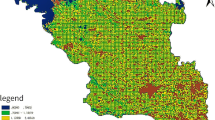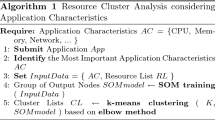Abstract
The increasing social problems on population, resources and environment enable the interaction between nature and humanity to become one of the most active research fields in the world. In this paper, we propose a novel framework of human–land sustainable computational system, which fully advances the progress of the development of our society utilizing the cloud computing and big data analysis technologies. Particularly, the study on quality of land management has attracted much attention. With the proposed framework, multi-user multi-cloud environment (MUMCE) is firstly presented, and evaluation of land quality is regarded as various services, such as soil acidity and alkalinity, soil thickness, soil texture, smoothness and field layout. Then, this paper formulates the problem of formal concept analysis-based multi-cloud composition recommendation with regard to multiple users. To address this problem, this paper first adopts the collaborative filtering to obtain the services request of the target user, then the service–provider concept lattices are constructed, and finally the best multi-cloud composition is selected and further recommended for the target user. Meanwhile, the corresponding algorithm is also devised. A case study is conducted for evaluating the feasibility and effectiveness of the proposed approach.





Similar content being viewed by others
References
Wei Y, Blake MB (2010) Service-oriented computing and cloud computing: challenges and opportunities. IEEE Internet Comput 14(6):72–75
Choi J, Ahn S (2019) Scalable service placement in the fog computing environment for the IoT-based smart city. J Inf Process Syst 15(2):440–448
Ardagna D, Nitto ED, Mohagheghi P et al (2012) MODAClouds: a model-driven approach for the design and execution of applications on multiple clouds. In: Workshop on Modeling in Software Engineering
Li B, Liu C, Studies U (2017) Emerging selective regimes in a fragmented authoritarian environment: the a ‘three old redevelopment’ policy in Guangzhou, China from 2009 to 2014. Urban Stud 2:004209801771684
Logan JR (2018) People and plans in urbanising China: challenging the top-down orthodoxy. Urban Stud 55:004209801876355
Kuang L, Hao F, Yang LT et al (2014) A tensor-based approach for big data representation and dimensionality reduction. IEEE Trans Emerg Top Comput 2(3):280–291
Wei LY, Yeh MY, Lin G et al (2014) Discovering point-of-interest signatures based on group features from geo-social networking data. In: Technologies and Applications of Artificial Intelligence. IEEE, New York
Lee CH, Wang YH, Trappey AJC et al (2014) Applying geo-social networking and the theory of inventive problem-solving in service innovation and evaluation. J Chin Inst Ind Eng 31(2):13
Web Service Composition with Case Based Reasoning (2003). In: Proceedings of the 14th Australian Database Conference. http://crpit.com/confpapers/ RPITV17Limthanmaphon.pdf
Hamadi R, Benatallah B (2003) A Petri net-based model for web service composition. In: Australasian Database Conference. Australian Computer Society, Inc
Chakraborty D, Joshi A (2001) Dynamic service composition: state-of-the-art and research directions. Technical Report TR-CS-01-19, CSEE, UMBC
Cao L, Li M, Cao J (2005) Cost-driven web service selection using genetic algorithm. In: International Workshop on Internet and Network Economics. Springer, Berlin, Heidelberg, pp 906–915
Zou G, Chen Y, Xiang Y, Huang R, Xu Y (2010) AI planning and combinatorial optimization for web service composition in cloud computing. In: Proceedings of CCV Conference, May 17–18, 2010, Singapore
Microsoft Communications & Media Industries (2013) Multi-cloud service delivery and end-to-end management. Ref. Architecture
Liu Z-Z, Chu D-H, Song C, Xue X, Lu B-Y (2016) Social learning optimization (SLO) algorithm paradigm and its application in QoS-aware cloud service composition. Inf Sci 326:315–333
Ramrez A, Parejo JA, Romero JR et al (2016) Evolutionary composition of QoS-aware web services: a many-objective perspective. Expert Syst Appl 72:357–370
Wu T, Dou W, Hu C, Chen J (2017) Service mining for trusted service composition in cross-cloud environment. IEEE Syst J 11(1):283–294
Zhang F, Hwang K, Khan SU et al (2016) Skyline discovery and composition of multi-cloud mashup services. IEEE Trans Serv Comput 9(1):72–83
Mezni H, Sellami M (2017) Multi-cloud service composition using formal concept analysis. J Syst Softw. https://doi.org/10.1016/j.jss.2017.08.016
Haithem M, Taher A (2018) A cloud services recommendation system based on fuzzy formal concept analysis. Data Knowl Eng 116:S0169023X17304664
Pang B, Yang Y, Hao F (2019) A sustainable strategy for multi-cloud service composition based on formal concept analysis. In: The 17th IEEE International Conference on Smart City (SmartCity 2019), pp 2659–2665
Rajeswari M, Sambasivam G, Balaji N, Saleem Basha MS, Vengattaraman T, Dhavachelvan P (2014) Appraisal and analysis on various web service composition approaches based on QoS factors. J King Saud Univ Comput Inf Sci 26(1):143–152
Hao F, Sim D, Park D, Seo H (2017) Similarity evaluation between graphs: a formal concept analysis approach. J Inf Process Syst 13(5):1158–1167
Hao F, Park DS, Pei Z (2018) When social computing meets soft computing: opportunities and insights. Hum Centric Comput Inf Sci 8(1):8
Zhang WX, Qiu GF (2005) Uncertain decision making based on rough sets. Tsinghua University, Beijing, pp 12–58
Hao F, Yau SS, Min G, Yang LT (2014) Detecting \(k\)-balanced trusted cliques in signed social networks. IEEE Internet Comput 18(2):24–31
Wen Z (2008) Recommendation system based on collaborative filtering. In: CS229 Lecture Notes
Melville P, Sindhwani V (1997) Recommender systems. Encycl. Mach Learn 40:829–838
Acknowledgements
This research was supported by the National Natural Science Foundation of China (Grant No. 61702317), MSIT (Ministry of Science and ICT), Korea, under the ITRC (Information Technology Research Center) support program (IITP-2019-2014-1-00720) supervised by the IITP (Institute for Information and Communications Technology Planning and Evaluation) and the National Research Foundation of Korea (No. 2017R1A2B1008421) and was also supported by the Natural Science Basic Research Plan in Shaanxi Province of China (2019JM-379) and the Fund Program for the Scientific Activities of Selected Returned Overseas Professionals in Shaanxi Province (Grant No. 2017024).
Author information
Authors and Affiliations
Corresponding author
Additional information
Publisher's Note
Springer Nature remains neutral with regard to jurisdictional claims in published maps and institutional affiliations.
Rights and permissions
About this article
Cite this article
Pang, B., Hao, F., Yang, Y. et al. An efficient approach for multi-user multi-cloud service composition in human–land sustainable computational systems. J Supercomput 76, 5442–5459 (2020). https://doi.org/10.1007/s11227-019-03140-w
Published:
Issue Date:
DOI: https://doi.org/10.1007/s11227-019-03140-w




